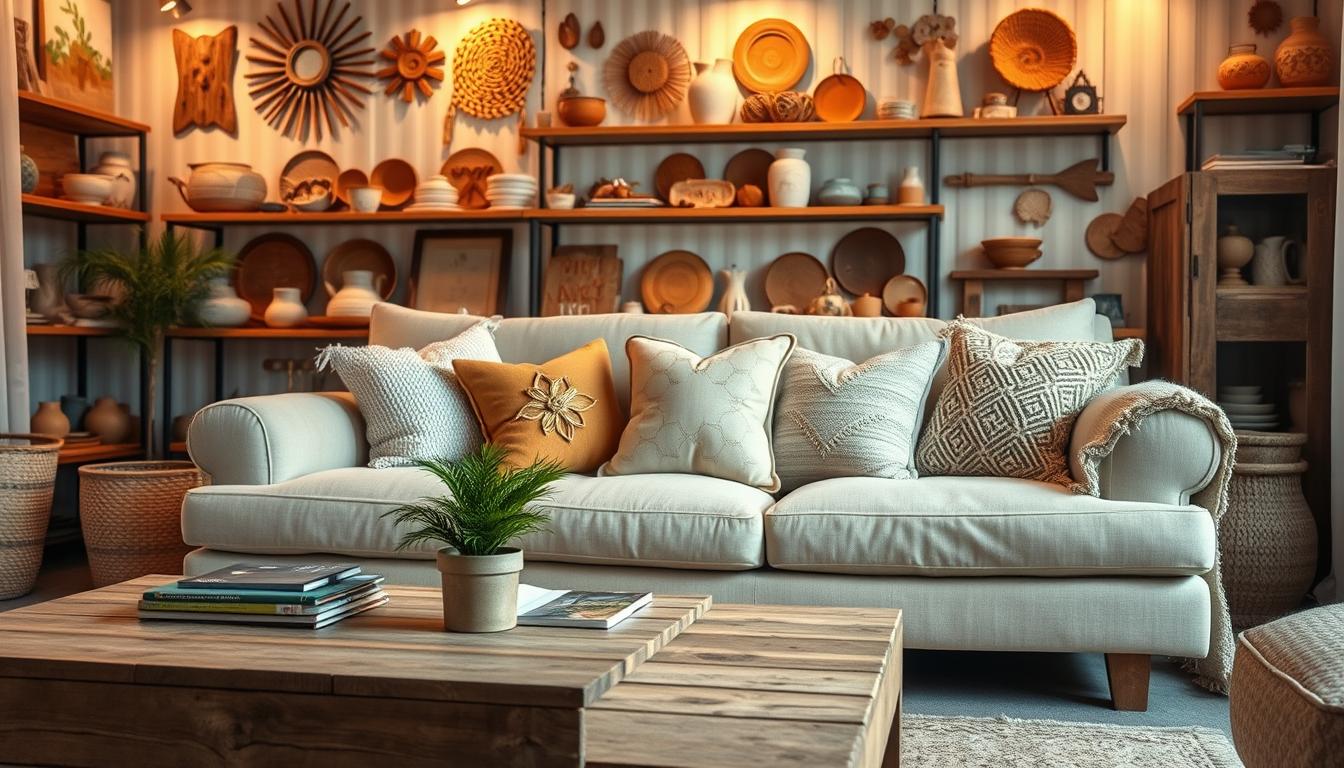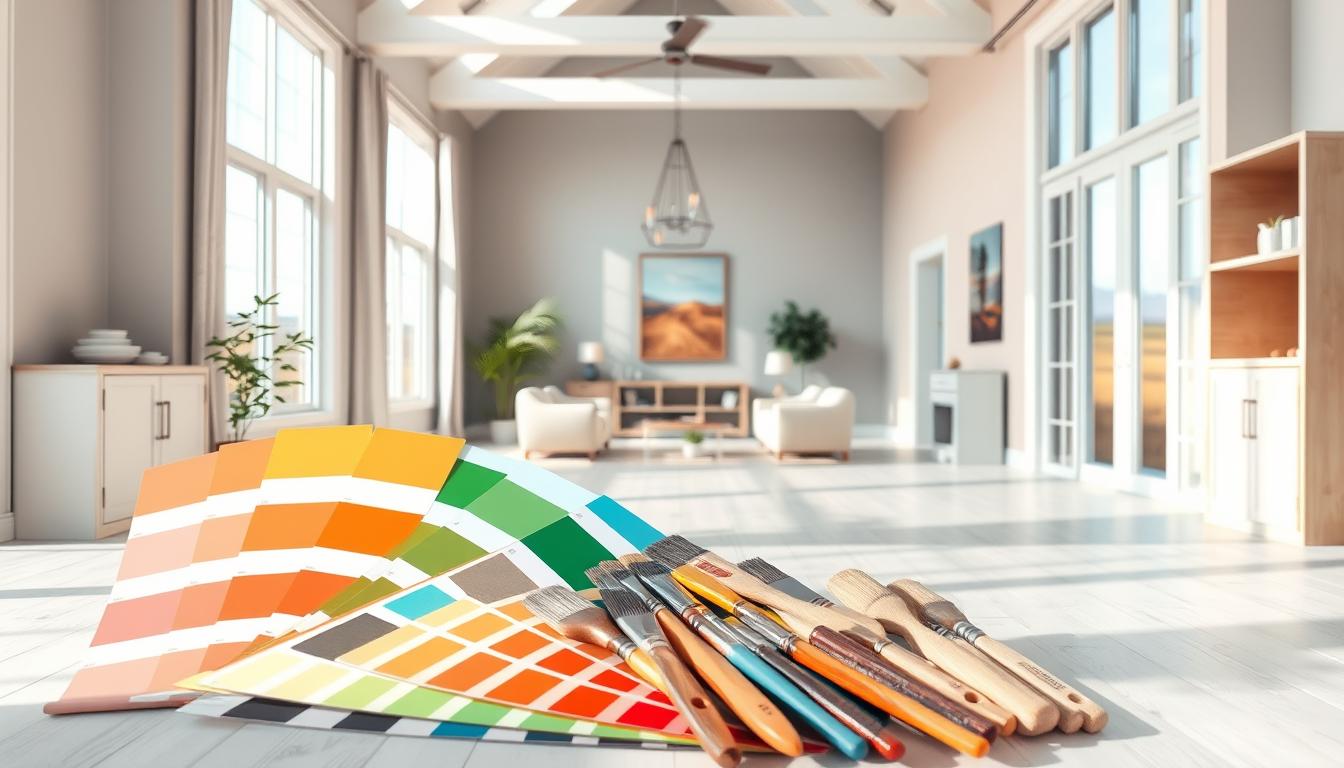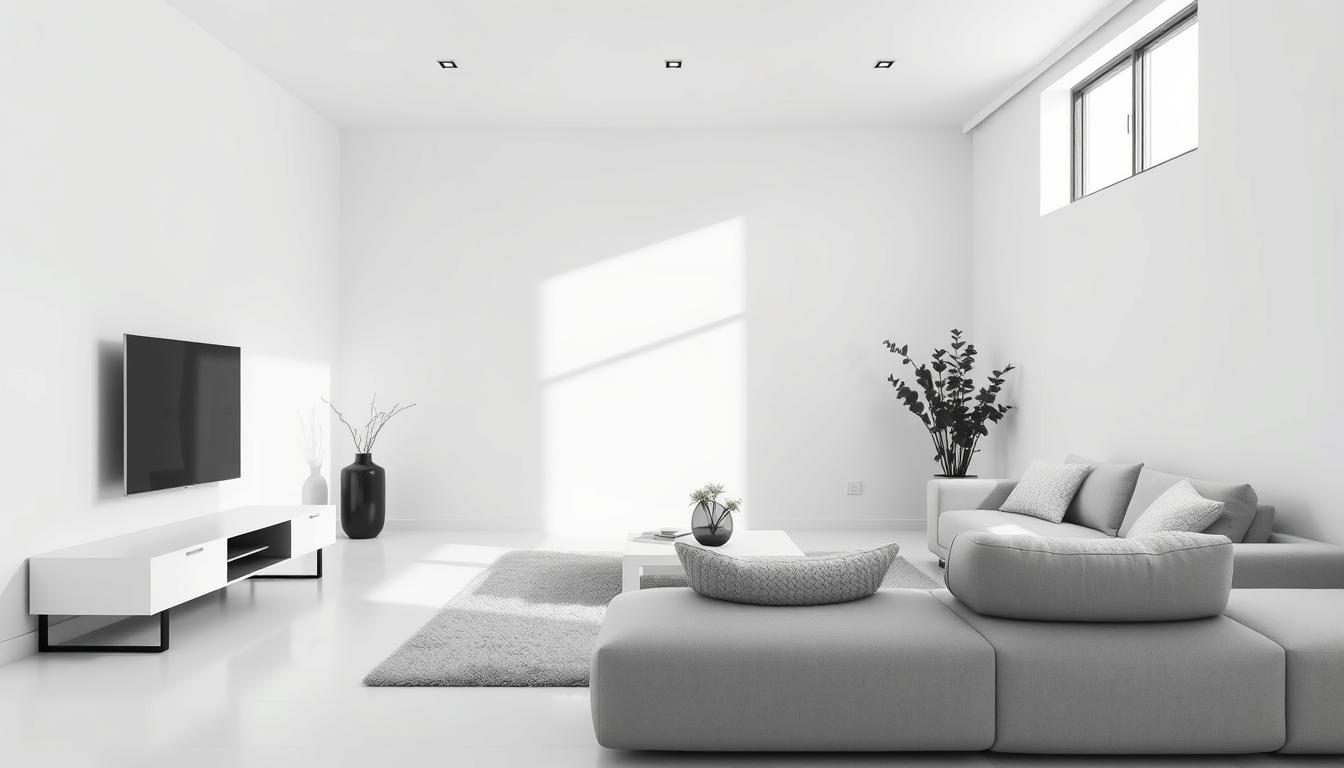Turning your living space into a beautiful haven doesn’t have to cost a lot. With a bit of creativity and smart planning, you can create a stunning interior that shows off your style.
Experts say decorating like a pro is easy. There are many tips and tricks to help you change your home without spending a lot. In this article, we’ll look at different DIY tips to give your space a new look without spending a lot.
Key Takeaways
- Simple and budget-friendly ways to enhance your living space
- Creative DIY projects for a unique interior
- Tips for choosing the right decor for your home
- Ideas for rearranging your furniture for a fresh look
- Easy DIY decor projects to get you started
Understanding the Basics of DIY Home Interior Design
DIY home interior design is more than just decorating. It’s about making a space that shows who you are. When we do DIY projects, we save money and follow our own style. We create a home that tells our story.
Understanding your personal style is key in DIY home design. Your home should reflect your personality, interests, and values. A design expert said, “When our clients hired us, they wanted to include inherited furniture,” showing the importance of personal touches.
The Importance of Personal Style
Personal style in interior design means choosing things that speak to you. This could be a vintage piece, a color palette, or a texture. It makes your space unique and welcoming. To add your personal style to DIY projects, consider these tips:
- Identify your favorite colors, textures, and furniture styles.
- Think about the memories or feelings you want your space to evoke.
- Mix and match different elements to create a unique look.
Key Elements of Interior Design
Good interior design includes line, shape, color, texture, and space. Knowing how to balance these elements is key for a harmonious and functional space.
| Element | Description | Example |
|---|---|---|
| Line | Defines the shape and form of a space | Furniture edges, architectural details |
| Shape | Geometric or organic forms that add visual interest | Circular tables, rectangular sofas |
| Color | Affects mood and perception of space | Wall paint, furniture upholstery |
| Texture | Adds depth and tactility | Rugs, throw blankets, wood furniture |
| Space | The negative space around and between objects | Room layout, furniture arrangement |
Common DIY Design Mistakes
DIY home interior design gives you freedom but has pitfalls. Common mistakes include furniture that’s too big, ignoring lighting, and poor room flow.
By knowing the basics of DIY home interior design, you can make a home that’s both beautiful and useful. Whether you’re doing DIY projects or looking for affordable decorating, the key is to have a clear vision and be creative.
Choosing a Color Palette for Your Home
A well-chosen color palette can change your living space and improve your well-being. When picking home decor inspiration, the colors you choose are key. They set the mood for your whole home.
Choosing the right colors can seem hard, but it’s vital for interior design tips. It can make or break your home’s feel. Let’s look at how colors affect our mood and give tips for picking colors that go well together.
How Colors Affect Mood
Colors deeply affect our emotions and mood. Warm colors like red, orange, and yellow bring energy and warmth. Cool colors like blue, green, and purple calm us down. Knowing this helps create a color palette that makes your home feel better.
Think about what each room needs. For example, a bedroom might need soothing colors like light blue or pale green. A living room could be more lively with terracotta or golden yellow.
Tips for Selecting Complementary Colors
Choosing colors that go well together can be tricky. But here are some easy home improvement ideas to help:
- Begin with a neutral color that connects all rooms.
- Use the 60-30-10 rule: 60% of a main color, 30% of a secondary color, and 10% of an accent color.
- Think about your home’s natural light and how it changes color choices.
- Feel free to try different shades and tones until you find the perfect mix.
By using these interior design tips and thinking about color’s impact on mood, you can make a color palette that improves your home’s feel. It will also give you home decor inspiration for a long time.
Creating Functional Spaces
Functional spaces are key to a great home. They should look good and work well. When we renovate, making the most of space is crucial.
Zoning is important. It means dividing the home into areas for different activities. This makes living easier and more organized.
Zoning: A Key to Organized Living
Zoning means setting up areas for things like cooking, dining, and relaxing. It makes our homes more functional and fun.
In open-plan homes, zoning can be done with furniture, lights, and colors. Here are some tips:
- Use area rugs to define different zones within an open-plan space.
- Employ different lighting schemes to create ambiance in various areas.
- Select furniture that is proportionate to the size of each zone.
Transforming Small Areas
Turning small areas into useful spaces needs creativity and smart design. Using furniture that does more than one thing is a good idea. Think about a storage ottoman or a coffee table with storage.
To make small rooms look bigger, try smart layouts. For example, a mirror opposite a window can make a room seem larger by reflecting light.
| Design Element | Purpose | Benefit |
|---|---|---|
| Area Rugs | Define zones | Creates a sense of separation |
| Multi-functional Furniture | Serve multiple purposes | Saves space and enhances functionality |
| Mirrors | Create illusion of space | Makes rooms appear larger |
By using these creative ideas and affordable decor tips, we can make our homes both useful and beautiful. This improves our lifestyle.
In summary, making functional spaces is about knowing what we need and using smart design. Whether it’s zoning or making small areas bigger, our goal is a home that’s both useful and nice to look at.
Furniture Arrangement Techniques
Getting your furniture right is key to a cozy and useful living space. It’s not just about where you put things. It’s about making your home look great and feel welcoming.
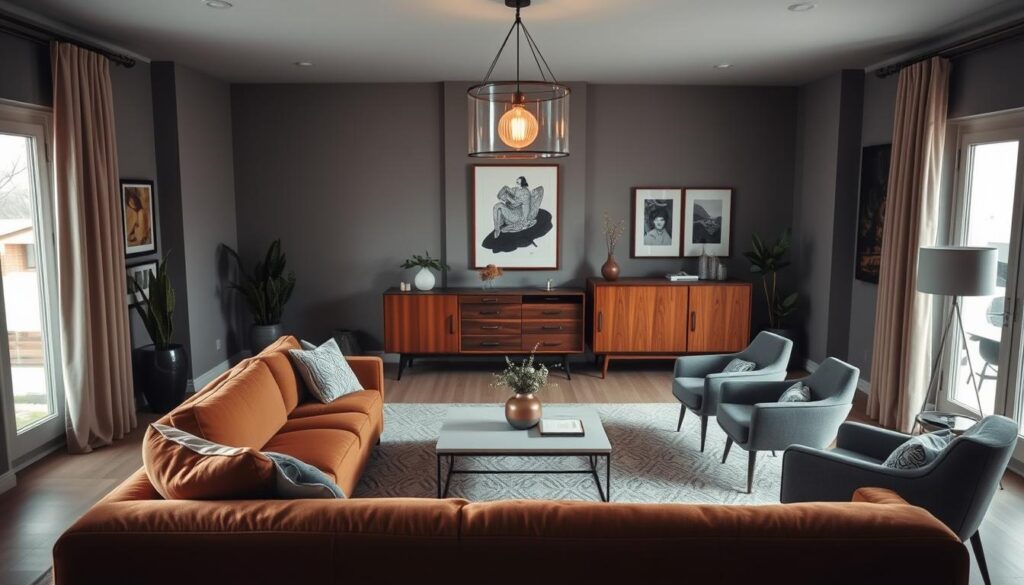
The 30-30 Rule of Furniture Layout
The 30-30 rule is a simple trick for arranging furniture. It says to keep 30 inches between furniture and 30 inches from walls. This makes your space look neat and balanced.
Using this rule, your rooms will feel bigger and easier to move around. For example, in a living room, place a sofa away from the wall. Then, add chairs and a coffee table to create a cozy spot.
Utilizing Multi-Functional Furniture
In today’s tight spaces, multi-functional furniture is a big hit. Items like storage ottomans, sofa beds, and coffee tables with storage add value to any room.
For instance, a storage ottoman can be a footrest, extra seat, and storage for blankets or toys. A murphy bed is perfect for small apartments, turning a bedroom into a living area by day.
Creating Flow Between Rooms
It’s important to make moving between rooms easy. Make sure furniture in one room doesn’t block the way to another. For smooth transitions, check out furniture arrangement tips that help with flow.
A U-shape or H-shape conversation area is great. It encourages talking and makes the room feel cozy. Design experts say these shapes make rooms more inviting and comfy.
Lighting: An Essential Element
Lighting is key in home decor. It sets the mood and makes a room look better. It lights up spaces, adds ambiance, and shows off architectural details.
Different Types of Lighting
Knowing the types of lighting is important. There are three main kinds: ambient, task, and accent lighting.
- Ambient Lighting: Lights up a room for moving around and doing everyday things.
- Task Lighting: Focuses on areas for specific tasks, like reading or cooking.
- Accent Lighting: Shows off special features or areas, adding interest and depth.
| Type of Lighting | Purpose | Examples |
|---|---|---|
| Ambient | General Illumination | Ceiling fixtures, Chandeliers |
| Task | Specific Tasks | Desk lamps, Under-cabinet lighting |
| Accent | Highlight Features | Spotlights, LED tape lights |
DIY Lighting Projects
Doing DIY lighting projects is fun and creative. Here are some ideas to start:
- Turn old jars or containers into unique pendant lights.
- Make a mason jar chandelier for a rustic look.
- Use LED strip lights for ambient lighting under furniture or along baseboards.
By using these lighting ideas and DIY projects, you can make your home look and feel better. It will become a more welcoming and enjoyable place.
Incorporating Textures and Patterns
Adding textures and patterns to your home decor can instantly elevate its aesthetic appeal. By thoughtfully combining different elements, you can create a rich and inviting atmosphere that reflects your personal style.
Mix and Match Textiles
One of the most effective ways to incorporate textures and patterns is through the use of textiles. Mixing different fabrics, such as velvet, linen, and cotton, can add depth and visual interest to your space. For example, pairing a velvet sofa with linen curtains and cotton throw pillows creates a layered look that is both stylish and inviting.
When mixing textiles, consider the color palette and texture of each piece. Choose items that complement each other, and don’t be afraid to combine different patterns, such as stripes and florals, to create a unique and personalized look.
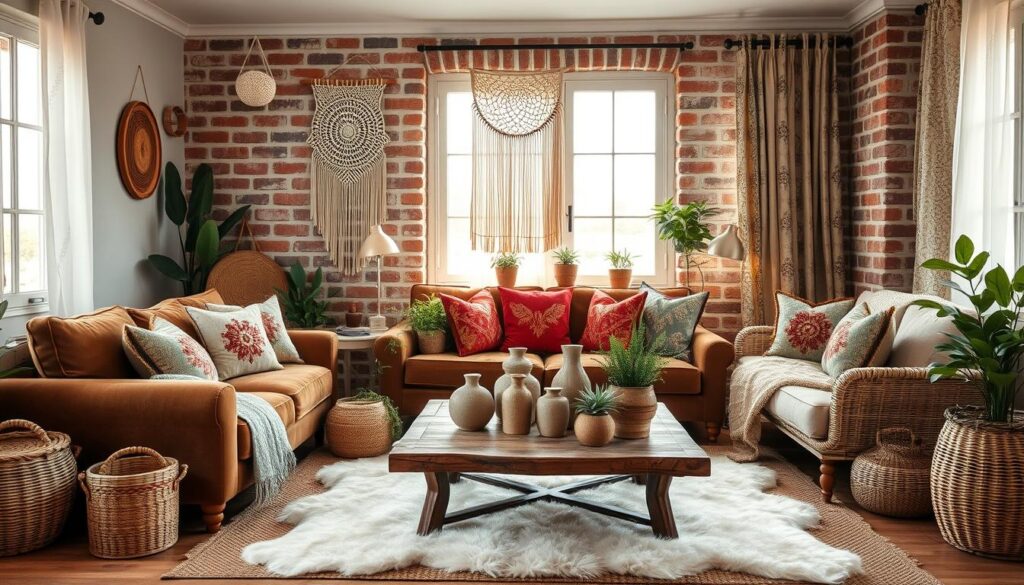
Using Wallpaper Creatively
Wallpaper is another excellent way to incorporate patterns and textures into your home decor. With a wide range of designs available, from subtle textures to bold patterns, you can use wallpaper to create a statement wall or add visual interest to a room.
When using wallpaper, consider the overall aesthetic you want to achieve. For a bold look, choose a statement wallpaper with a large pattern. For a more subtle look, opt for a texture or a small-scale pattern. Remember to balance your wallpaper with the rest of your decor to avoid overwhelming the space.
| Texture/Pattern | Description | Example |
|---|---|---|
| Velvet | Luxurious fabric with a soft, plush pile | Velvet sofa or throw pillows |
| Linen | Natural fabric with a textured, woven look | Linen curtains or a linen-upholstered chair |
| Stripes | Classic pattern that adds visual interest | Striped rug or striped wallpaper |
| Florals | Timeless pattern that adds a touch of elegance | Floral throw pillows or floral wallpaper |
By incorporating a mix of textures and patterns, you can create a home environment that is both stylish and inviting. Whether through textiles or wallpaper, the key is to balance different elements to achieve a cohesive look that reflects your personal style.
Adding Personal Touches to Your Decor
Making your home truly yours is more than picking furniture and colors. It’s about adding personal touches that tell your story. These elements make your space unique and warm.
Interior designer Maggie Clarke says, “I love incorporating meaningful pieces into designs,” it gives the space soul.” This shows how important personal touches are in home decor. Adding items with sentimental value makes your space feel truly yours.
The Power of Art and Photography
Art and photography add personality to your home. They can evoke emotions and spark conversations. Choose pieces that resonate with you personally.
- Choose artwork that reflects your personal style or interests.
- Consider the emotional impact of the piece and how it makes you feel.
- Don’t be afraid to mix different styles or periods to create a unique look.
Incorporating Family Heirlooms
Family heirlooms add history and remind you of loved ones. They make your space special. Think about how to display or repurpose them in your design.
“The most memorable homes are those that are filled with personal touches, making them unique and special.”
Here are some ideas for using family heirlooms:
- Display vintage items on a decorative shelf or mantle.
- Repurpose old furniture with a fresh coat of paint or new upholstery.
- Create a gallery wall with family photographs and heirlooms.
By adding personal touches like art, photography, and family heirlooms, you make your home beautiful and deeply personal.
Seasonal Decor Changes
Changing your home decor with the seasons is fun and creative. It keeps your space lively and engaging. As we move from one season to another, our homes can show off each time’s unique qualities.
Fresh Ideas for Each Season
Every season has its own charm and style. Spring is all about soft colors and flowers. Summer is bright and outdoorsy, so bring the outside in. Autumn brings warm colors and natural elements like leaves.
Winter is the time for rich colors and cozy textiles. “The key to successful seasonal decorating is to balance the season’s themes with your home’s style,” says an interior design expert. “It’s about enhancing your decor, not changing it all.”
DIY Projects for Seasonal Updates
Updating your decor seasonally doesn’t have to cost a lot. Here are some budget-friendly DIY ideas:
- For spring: Make a floral wreath or a pastel garland for your windows.
- For summer: Turn old jars into plant vases or make a seashell wind chime.
- For autumn: Create a leaf garland or a centerpiece with pinecones and candles.
- For winter: Hang a snowflake decoration or make a cozy throw blanket.
These DIY projects are easy home improvement ideas. They add a personal touch to your decor. With budget-friendly decor hacks like these, your home stays fresh and exciting all year.
Embracing seasonal decor changes keeps your home feeling new and updated. Whether you’re looking for home decor inspiration or new DIY projects, there’s something for everyone.
Sustainable and Eco-Friendly Design
Sustainable design is key for our planet’s future, starting in our homes. As we learn more about our environmental impact, making eco-friendly choices in home design is crucial. It includes reducing waste and using materials that are better for the environment.
One easy way to support sustainable design is by upcycling or repurposing materials. This not only cuts down on waste but also brings a unique flair to our homes.
Upcycling Old Furniture
Upcycling old furniture breathes new life into items that might be thrown away. Transform old pieces with spray paint and affordable refinishing kits, experts advise. It saves money and lessens the need for new, resource-heavy furniture.
- Find old furniture in thrift stores or online.
- Use eco-friendly paints or stains for a fresh look.
- Think about repurposing furniture, like turning an old door into a coffee table.
Green Materials to Consider
The materials we choose are vital in sustainable design. Choosing green materials can greatly lessen our environmental impact. Here are some green materials to consider:
| Material | Benefits | Uses |
|---|---|---|
| Bamboo | Fast-growing, renewable, and durable | Flooring, furniture, decorative items |
| Recycled Glass | Reduces waste, energy-efficient | Countertops, decorative accents, lighting fixtures |
| Sustainably Sourced Wood | Certified by organizations like the FSC, ensures responsible forestry practices | Furniture, flooring, paneling |
By using these materials and practices in our home design, we can create spaces that are both stunning and sustainable.
Budget-Friendly DIY Design Hacks
Transforming your home doesn’t have to cost a lot. With these DIY design hacks, you can make your space stylish without spending much. It’s all about being creative and resourceful.
One great way to decorate on a budget is to look for decor items in unexpected places. For example, you can change your room’s look by painting it a new color. You can also swap out your lamps and light fixtures and add new accessories.
Thrifting for Home Decor
Thrifting is a fantastic way to find unique decor items without spending a lot. You can find amazing pieces at thrift stores, garage sales, or online. When you thrift, keep an open mind and see the potential in each item.
- Look for items that can be repurposed or upcycled.
- Consider the condition and whether it can be restored.
- Think about how the item fits with your overall decor theme.
Thrifting not only saves you money but also helps the environment by giving old items a new life. For example, an old ladder can become a bookshelf, or vintage jars can be used as vases.
Repurposing Everyday Items
Repurposing everyday items is a creative way to save money and add character to your home. Think outside the box and find new uses for common items.
“You don’t have to buy new to decorate; get creative with what you already have.”
Some ideas include:
- Using old mason jars as pendant lights or vases.
- Transforming an old door into a coffee table or headboard.
- Utilizing cardboard boxes for storage solutions.
By using these DIY design hacks, you can create a home that shows your style without breaking the bank. The secret is to be creative and resourceful.
Conclusion: Embrace Your Creativity
As we wrap up our DIY home interior design journey, we urge you to let your creativity shine. Try out different design ideas and use the tips we’ve shared. This way, you can make a stylish and useful living space that shows off your personal style.
Experiment with Confidence
Don’t hesitate to try new things and take chances in your design projects. With DIY home interior design, you can turn your space into a welcoming and stunning place. Use stylish home design trends to add your own unique touch.
Explore Further Resources
To keep improving your home design skills, check out online resources, design blogs, and home decor magazines. Also, visit home decor stores and showrooms to see the latest trends. By embracing your creativity and staying informed, you can make a home that’s both beautiful and practical. It will also show off your personal taste in line with current stylish home design trends.

